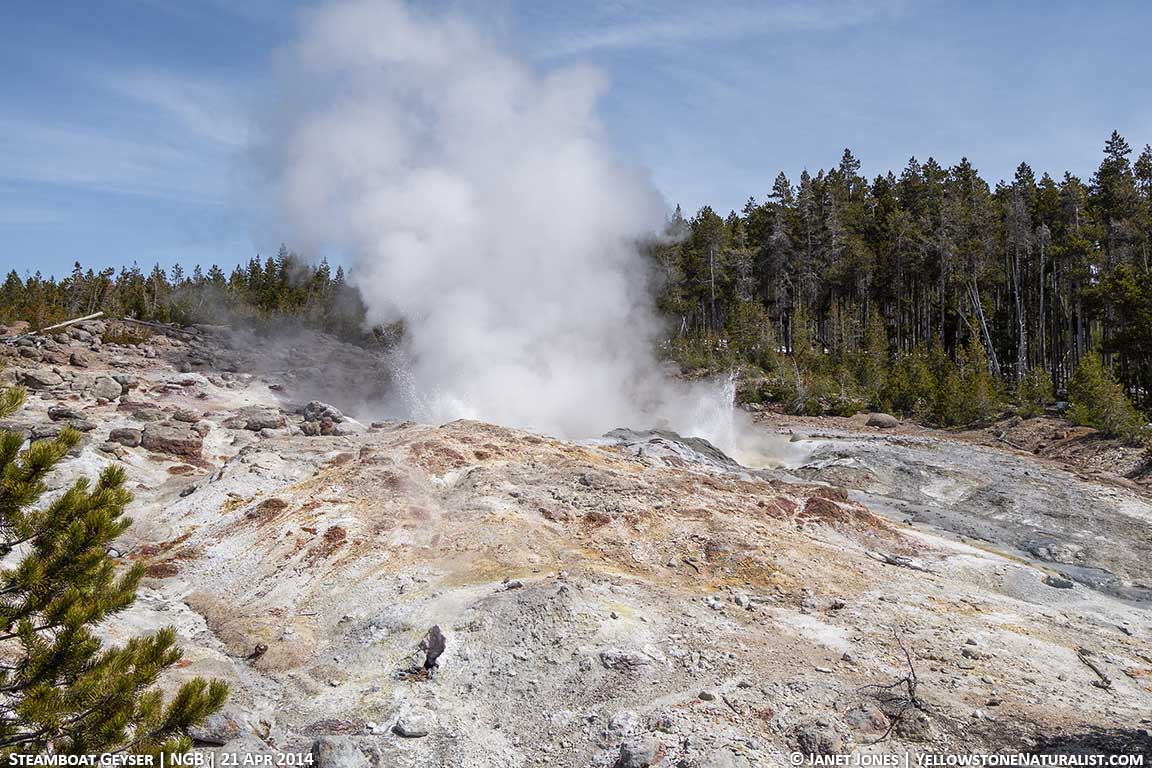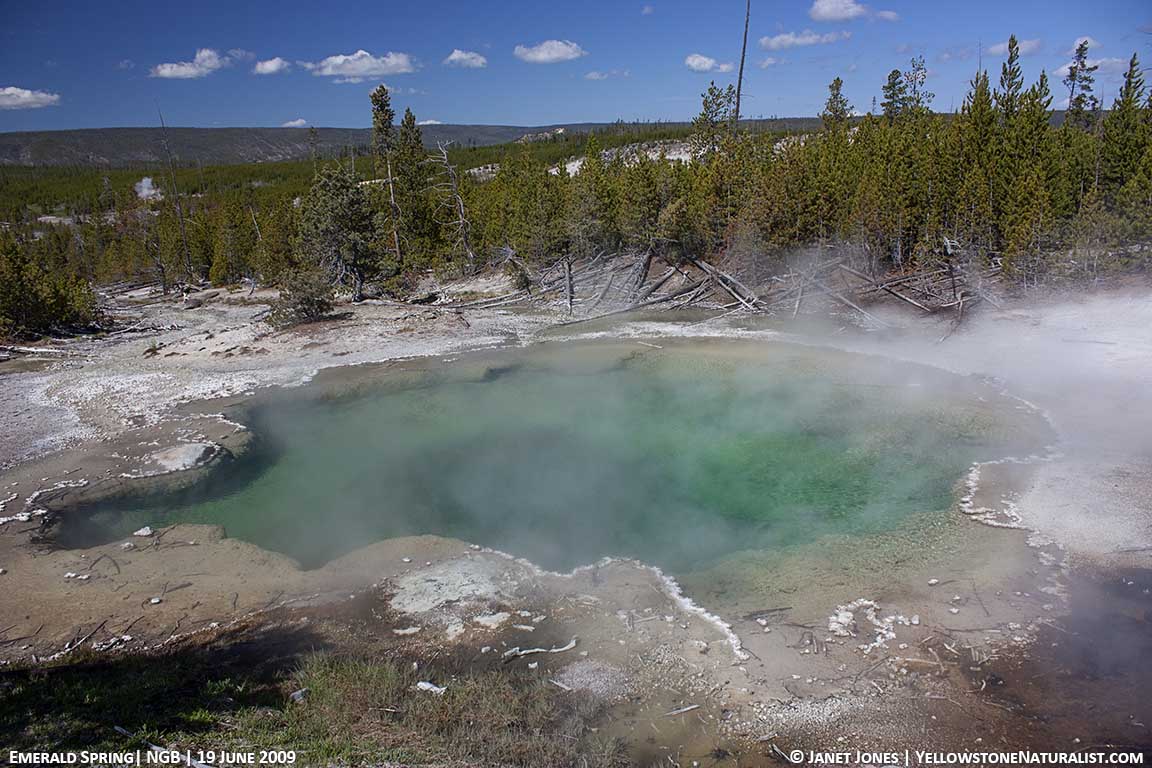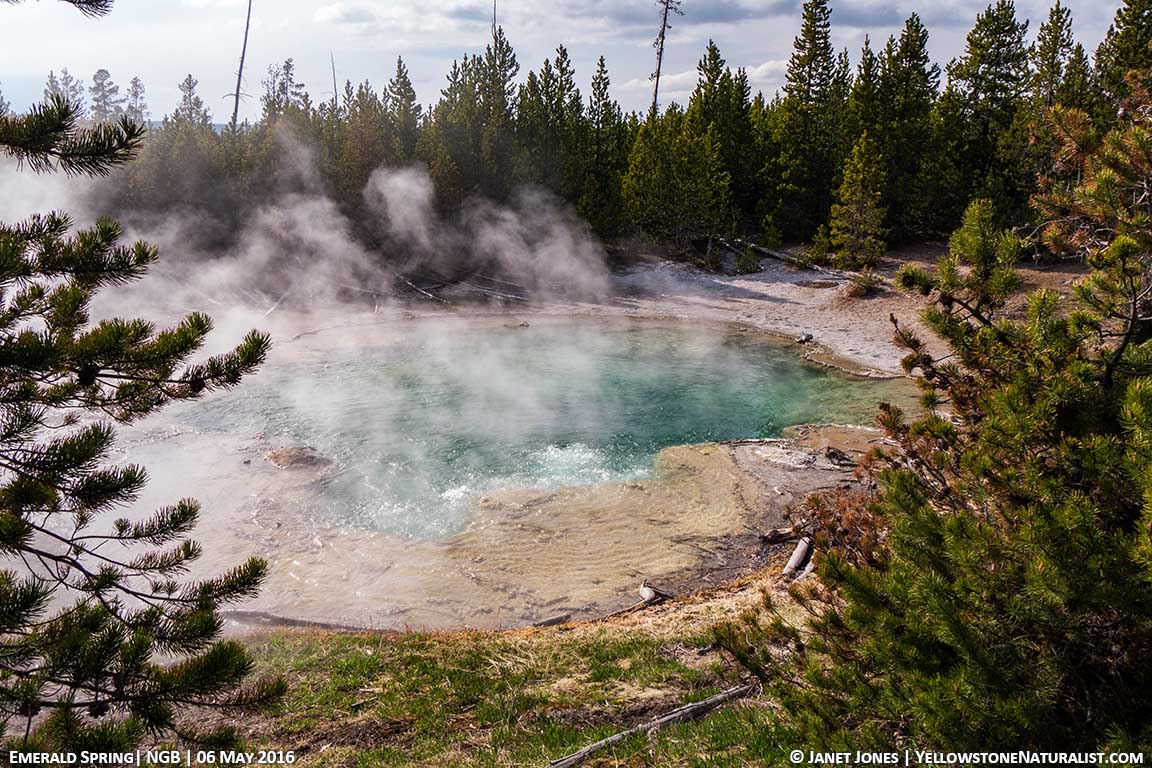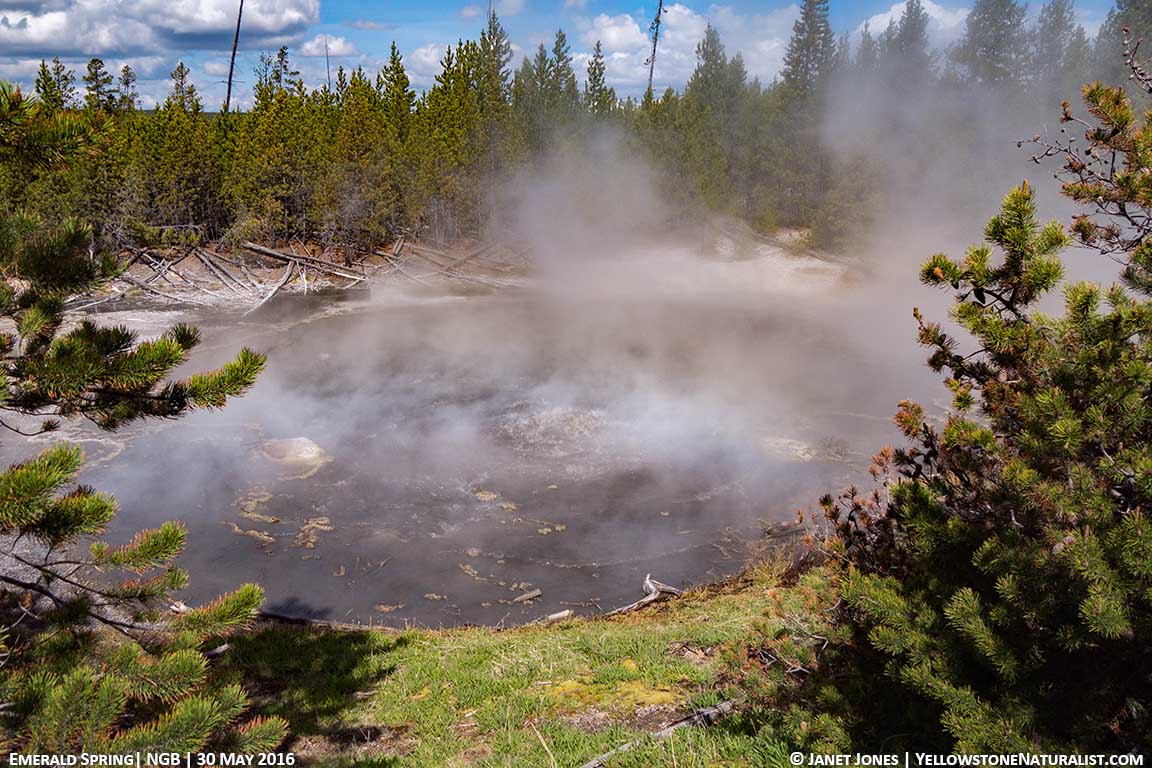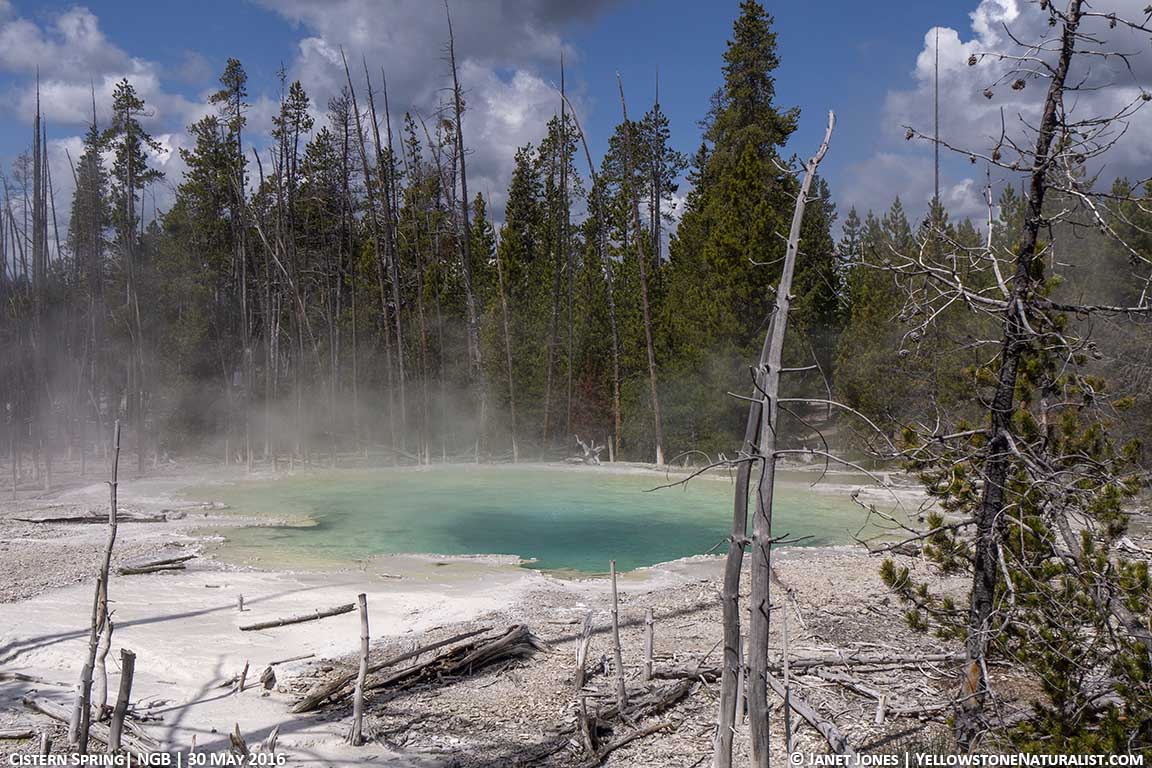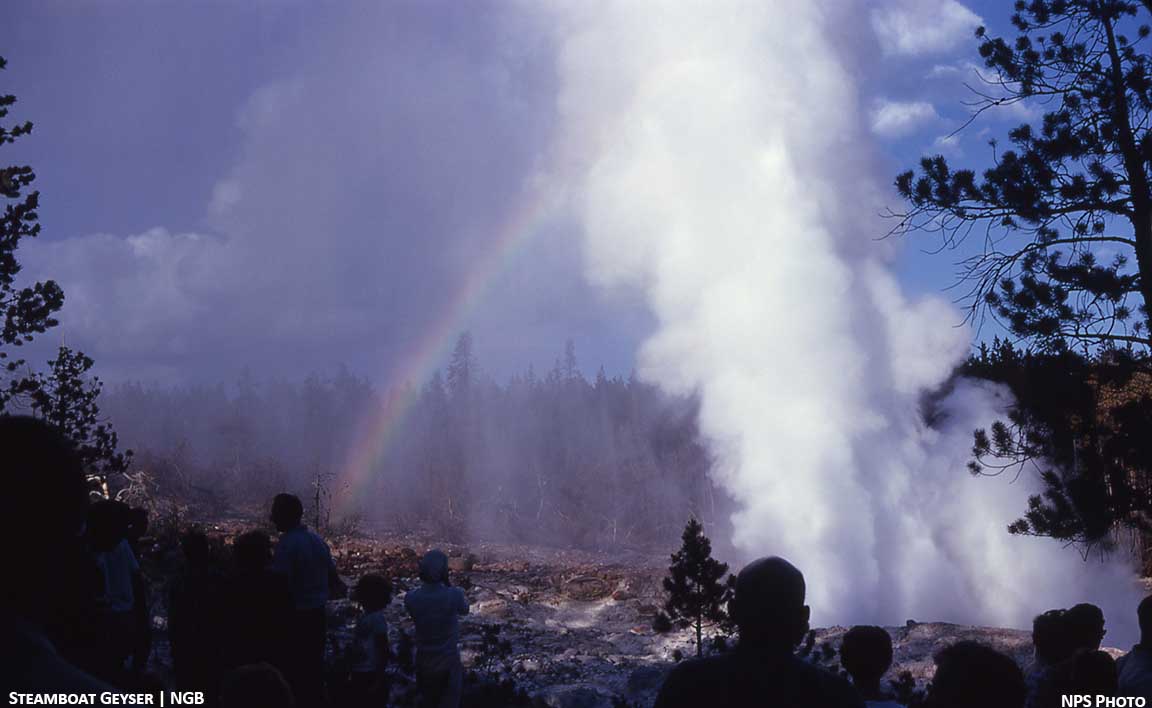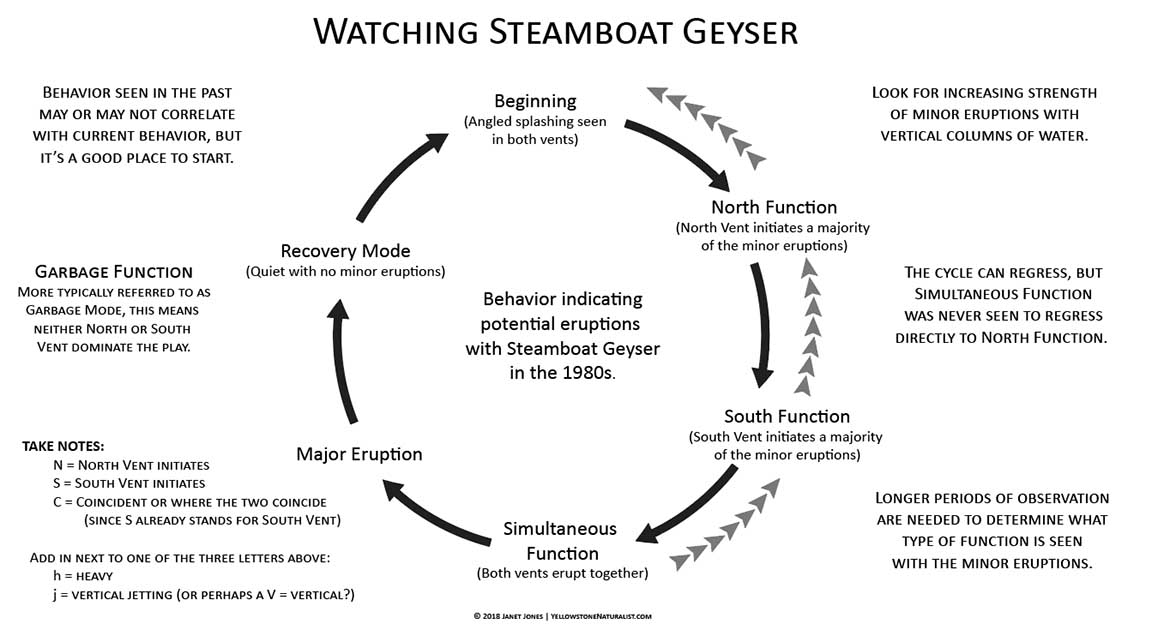Watching Steamboat Geyser
Is Steamboat Geyser entering an active phase? That’s the question many are asking and in this in-depth post, we’ll take a closer look at Steamboat Geyser’s past behavior and learn from those who documented the behavior when it was regularly active.
35 Days 11 hours 9 minutes between eruptions. This stunningly short interval for Steamboat Geyser, the world’s tallest geyser, gives a renewed hope that perhaps Steamboat is entering into an active phase full of more frequent eruptions (frequent for this geyser means about every month or every week). This would give us more insight into the behavior of this powerful geyser that many still have on their “life list” of geysers to see in person – in particular to be able to catch the brief water phase of the eruption.
The active phase Steamboat Geyser entered into in the 1980s seemed to start like what we have right now. Two eruptions about a month apart. Then it had a third with only a ten day interval. After that the eruptions happened about every week or so until a basin-wide disturbance (a normal occurrence at Norris Geyser Basin) slowed things down a bit. Time will tell! It could also be a repeat of what was seen in 2003. There were two eruptions about a month apart (March and April) and then a third in October and nothing more until October of that year followed by nothing until 2005. So it’s a bit premature to jump to the conclusion that we’re entering an active phase, this second eruption has perked up interest in Steamboat and got me digging into my research again to learn more and refresh my memory.
It is with deep thanks to all who spent time gathering observations and sorting out patterns in the past – especially Paul Strasser, Suzanne Strasser and Bill Pulliam. Their work, published in the Geyser Observation and Study Association Transactions journal, give invaluable insight into what we might look for as we wait and hope that Steamboat is becoming active once again. However, keep in mind that geysers are geysers and can shift and change behavior, so while the past observations may prove an accurate predictor, it’s best to confirm this rather than assuming it.
Watching Steamboat Geyser takes an investment of time to gather enough information to know exactly what’s happening. That means a quick look isn’t enough with Steamboat. Given that most visitors are not going to have the time to spend observing, and that most park rangers are busy with other duties with their jobs and can only give limited time to geyser behavior, this is where the geyser gazers fill in the gap. These individuals visit the park often and have come to know the thermal features well. Most of us share the times of geyser eruptions and short observations on Geyser Times. If Steamboat is entering another active phase, then this site is a great place to watch for information.
ABOUT STEAMBOAT GEYSER
Steamboat Geyser eruptions have been measured at over 377 feet (115 meters) and estimated through photos at 426 feet (130 meters). Waimangu Geyser in New Zealand was taller, but stopped erupting in 1904. Steamboat’s also perhaps the loudest geyser in the world was well, especially as it changes from the water phase of the eruption to the steam phase.
Steamboat Geyser is located on a hillside in Norris Geyser’s Back Basin, and while the full loop is longer than many people wish to take on their vacation, the walk down to Steamboat Geyser doesn’t take terribly long. However, remember that any hill you descend, you’ll need to climb back up again. At the altitude of about 7500 feet (2286 meters) that means being in good enough shape to take this small hike.
Steamboat has two vents: a “north” one (that lies higher on the hillside) and a “south” one (lower on the hillside). While there are two vents within the south area, only one erupts, and the lowest one acts as a drain. While technically the vents are on a northwest/southeast line, they are simply referred to as North Vent and South Vent.
CONNECTIONS
Emerald Spring
As you walk toward Steamboat Geyser, you first pass what’s usually a lovely green pool, known as Emerald Spring that sometimes boils some on one side. There is some evidence that suggests a possible connection with Steamboat Geyser, but this has not been studied enough to know for certain – in large part due to the fact that Steamboat needs to give us more opportunities to collect observations. However, heavy boiling or turbidity along with irregular eruptions from Echinus does indicate a basin-wide disturbance. Disturbances during Steamboat’s active phases would result in a decline in that activity and it would take several weeks to recover.
Cistern Spring
Steamboat Geyser is known to have underground connections to Cistern Spring. This normally green or blue-green spring lies at the base of the hill, below Steamboat Geyser. As Steamboat erupts, the water in Cistern Spring slowly drops over a day, often completely emptying from our vantage point on the boardwalk. Because the eruptions of Steamboat Geyser toss out and disturb much dirt and debris, Cistern Spring can appear muddy after an eruption. Cistern Spring has erupted on rare occasions at about the time it starts to drain after an eruption of Steamboat Geyser, so it’s not a bad idea if you do catch an eruption of Steamboat from the start to take a peek down the hill at Cistern.
ERUPTIONS
Minor Eruptions
As you arrive at Steamboat Geyser, you’ll notice splashes coming regularly from both vents. They don’t last long and are definitely less than 75 feet (22 meters) and most much less than that. These are minor eruptions that happen pretty much continuously every minute or two. These have shown a pattern of behavior in the past that helped to give an idea of when a major eruption might happen. This is described below in What to Watch For.
Major Eruptions
Apparently, in the 1960s, Steamboat eruptions often began suddenly with a blast of water shooting skyward. This was referred to as a “Silver Bullet.” In the 1980s, one minor eruption witnessed qualified as a Silver Bullet. It shot up with tremendous force to delight a crowd who thought a major eruption had started only to quit suddenly as well, leaving the crowd wondering what had just happened. More commonly seen in the 1980s was a more leisurely start, with Steamboat taking its time to reach maximum height.
The column of water from the North Vent reaches the maximum height of 300 feet (91 meters) or more while the South Vent joins this column part way before splitting off on its own. The maximum height of the South Vent is lower than that of its neighbor.
After the beginning of an eruption, the water turns darker. There are two theories for this – and perhaps both contribute. Since the water from the eruptions lands uphill and runs back down to the vents, it brings extra debris with it. That logically would turn the water darker. There’s also a theory that major eruptions tap into a deeper water source that has a darker appearance to it. Either way, this shift to a darker color of water is normal.
After the short water phase (3 to 40 minutes has been cited in the past), the eruption shifts to a powerful steam phase so loud that you can’t hear someone shouting that’s standing next to you. The noise is reportedly intense and occasionally somewhat painful. However, each eruption can be different – some stronger than others.
This steam phase will last for many hours – as long as a day or more, slowly decreasing in intensity.
WHAT TO WATCH FOR
There is a relatively simple progression seen in the past that we can look for again if Steamboat becomes a focus of interest. While it may not apply to new behavior and we might have to start again with a clean slate, this is a good place to start.
When watching the frequent minor eruptions, it’s important to note which vent started first. If they shift back and forth often, and neither vent seems to dominate the play, then there’s not much to write home about. Garbage mode – or garbage function. In the 1980s, observations of an hour or more were helpful in determining which vent was dominating, or if it was in garbage mode.
The pattern to hope for is:
NORTH FUNCTION – This is when the north vent dominates in initiating the minor eruptions. These may start with thin jets of angled water that, over time, build into more powerful minor eruptions. Vertical water is a good sign. There still may be a few minor eruptions that start with the south vent, but the north vent is clearly in control.
SOUTH FUNCTION – Suddenly, the south vent takes over and begins to dominate the start of the minor eruptions. Again, vertical surges of water are a good thing.
At this point, the cycle may regress back to North Function. This is where it takes lots of observations to know what’s really happening.
SIMULTANEOUS FUNCTION – If the cycle continues, it will suddenly shift from the south vent dominating to both vents erupting at the same time, or within a second or two of each other, and the activity grows more powerful. It was mentioned that occasionally spray from the north vent came in the shape of a fan during this function.
And again, this cycle can regress from simultaneous function back to south function, but it has not been seen to regress from simultaneous function to north function.
If the cycle progressed, it would lead to a major eruption of Steamboat. This could come as soon as 8 hours or as long as 4 days. Lots of waiting time, but for those of us enchanted by the geysers, it’s time well spent.
A note of caution: Even if you spend an hour or more and see it in Simultaneous Function the whole time, that may not mean much if you don’t know if it’s gone through the cycle of North Function followed by South Function and then Simultaneous Function. This is the challenge of gathering observations and finding people willing to take “shifts” that keep Steamboat in more continuous observation.
Note Taking
A simple method to take notes on this is to use three letters:
N = North Vent initiates
S = South Vent initiates
C = Coincident or where the two coincide (since S already stands for South Vent)
Add in next to one of the three letters above:
h = heavy
j = vertical jetting (or perhaps a V = vertical?)
Then mark them in batches of tens so it’s easy to figure the percentage. With 30 to 40 minors per hour, that gives you a good sample and you can more easily see if there’s any difference. Or at least this is my plan for time spent there. It makes sense to just go with the same system as used in the 1980s for consistency. Then they used h to indicate heavy vertical jets and J to indicate vertical jetting.
In looking at this, I have to say I see it a bit confusing to use J for jetting because the jetting can be either angled or vertical. To me, it would be more accurate to use a V for vertical make it clear. I can see where they might see Nv as North Vent which also could be confusing. And that comes down to having a legend in your notes so people know what system you use – and it is much easier if everyone uses the same note taking system. But we’ll see what the general consensus is if it comes to that point – discussing this type of things is a delightful problem to have and I hope Steamboat gives us this.
While there are more complex observation notes used, this basic reference gives at least a starting point for us if Steamboat is ready to put on a good show in 2018. It may follow this same pattern or it may not, but won’t it be fun to find out?
References:
- Geyser Times
- [2008] Bryan, T. Scott, The Geysers of Yellowstone Fourth Edition, pp. 284-287 (affiliate link)
- [1990] Strasser, Strasser & Pulliam, “Investigations of patterns of minor and major activity of Steamboat Geyser, 1982-1984”, GOSA Transactions Volume 2, pp. 43-70
- [1988] Whittlesey, Lee, Wonderland Nomenclature: A History of the Place Names of Yellowstone National Park (manuscript), pp. 666-675
- [1964] Marler, George, “Norris Geyser Basin (revised 1964),” Yellowstone Geyser Observations and References, Vol. 3, pp. 7-9
Note: Unfortunately, the paper entitled “Steamboat Geyser” was not bound in this volume, and in its place is “The 1959 Hebgen Lake Earthquake Alters Yellowstone’s Hot Springs”. - [1960] Marler, George; “Norris Geyser Basin,” Yellowstone Geyser Observations and References, Vol. 2, p. 8.
- Header Image CC License: By Hsing-Mei Wu – Own work, CC BY-SA 3.0, https://commons.wikimedia.org/w/index.php?curid=17470513
